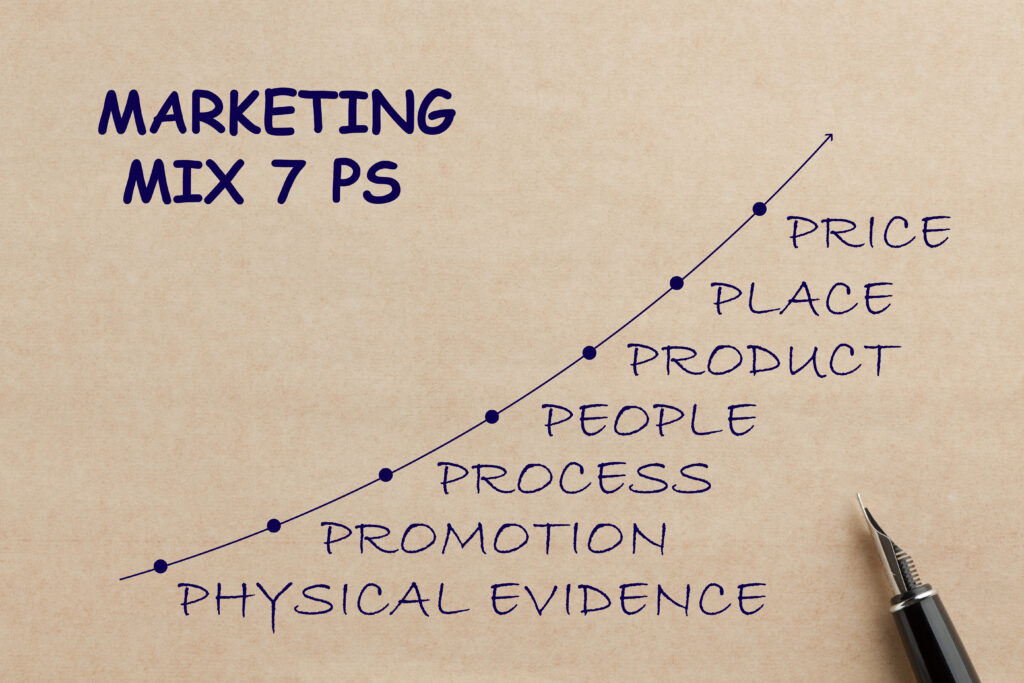
Marketing is always changing, but some basic ideas remain important. One key idea is the 7 Ps of Marketing, also called the Marketing Mix. These seven parts help businesses create and carry out marketing strategies that connect with their target audience, build brand awareness, and increase sales.
In this blog, we will explore each of the 7 Ps, explain how they shape your marketing strategy, and provide tips on using them effectively.
What Are the 7 Ps of Marketing?
E. Jerome McCarthy introduced the 7 Ps of marketing in the 1960s as the “marketing mix.” They offer a useful framework for businesses to organize their marketing efforts and provide value to customers. The 7 Ps are:
- Product
- Price
- Place
- Promotion
- People
- Process
- Physical Evidence
Let’s break each one down.
Product: Defining Your Product or Service
The first “P” is about the product or service a company offers its target audience. This is the foundation of the marketing mix because it defines the entire customer experience. The product should meet customers’ needs and desires.
Key Considerations:
- Is your product solving a problem or meeting a need?
- What are the features, benefits, and unique qualities of your product?
- How does it stand out in the market?
Tips for Using:
- Continuously improve your product based on customer feedback.
- Innovate and expand your product offerings to appeal to different groups.
- Focus on creating a strong value proposition that addresses customer pain points.
Price: Setting the Right Price for Maximum Profit
Price refers to what a customer pays to get your product or service. Setting the right price is important because it affects sales, profits, and how buyers see your brand’s value.
Key Considerations:
- What are the price points of competing products or services?
- Does the price reflect your product’s perceived value?
- Are you offering discounts or promotions to attract more customers?
Tips for Using:
- Use pricing strategies like penetration pricing (low prices to gain market share) or skimming pricing (high prices for premium products).
- Consider psychological pricing (e.g., $9.99 instead of $10) to influence buying behavior.
- Regularly review your pricing strategy to ensure it matches market demand and your brand’s value.
Place: Choosing the Right Distribution Channels
Place refers to the locations and channels through which your product or service reaches your target customers. This can involve physical stores, online platforms, or third-party retailers. Place is key to making sure your product is easy to reach for the right audience.
Key Considerations:
- Where do your customers shop or look for products?
- Do you need a physical store, an online shop, or both?
- How are you ensuring product availability?
Tips for Using:
- Choose the right mix of online and offline channels to maximize reach.
- Use e-commerce platforms, retail stores, and local distributors to broaden your product’s availability.
- Think about logistics and supply chain to ensure smooth delivery to customers.
Promotion: Effective Promotional Strategies
Promotion involves the activities and strategies you use to raise awareness about your product and encourage customers to buy it. This includes advertising, sales promotions, public relations, and social media marketing.
Key Considerations:
- How will you communicate your product’s benefits to your audience?
- Which promotional channels (TV, social media, email marketing) work best for your audience?
- How can you create urgency or excitement around your product?
Tips for Using:
- Use digital marketing strategies such as SEO, PPC, and social media ads to reach a wider audience.
- Offer limited-time promotions, discounts, or bundled offers to create urgency.
- Partner with influencers or affiliates to boost visibility and credibility.
People: The Importance of Customer Experience
People refers to the employees, representatives, and anyone who interacts with your customers. This element emphasizes how your team shapes the overall customer experience.
Key Considerations:
- How does your staff interact with customers?
- What is your team’s overall attitude toward customer satisfaction?
- Are you providing proper training to employees to represent your brand well?
Tips for Using:
- Train employees to create positive, engaging interactions with customers.
- Focus on providing exceptional customer service to build loyalty.
- Ensure that customer-facing staff are knowledgeable, friendly, and align with the brand’s values.
Process: Streamlining Your Operations for Success
Process refers to the systems that ensure your product or service is delivered efficiently. This includes how you handle customer orders, service delivery, returns, and customer support.
Key Considerations:
- How do your customers experience the purchase and delivery process?
- Are there any bottlenecks or inefficiencies in your workflow?
- How quickly and effectively can your team respond to customer inquiries?
Tips for Using:
- Automate customer service and sales processes to boost efficiency.
- Optimize the order fulfillment process to reduce delivery times and improve satisfaction.
- Continually evaluate and streamline business processes to ensure efficiency.
Physical Evidence: Establishing Credibility
Physical Evidence refers to the tangible elements that support your product or service, like packaging, branding, and the physical space where customers interact with your business.
Key Considerations:
- How is your product presented to customers?
- Does your website or physical location reflect your brand identity?
- Are you using branded materials (business cards, brochures, etc.)?
Tips for Using:
- Create visually appealing packaging that enhances how customers view your product.
- Ensure your website, social media profiles, and physical locations are well-branded and professional.
- Use testimonials, reviews, and certifications as social proof to build trust.
How to Use the 7 Ps in Your Marketing Strategy
Now that we’ve reviewed each of the 7 Ps, let’s look at how to integrate them into your marketing strategy.
- Align the 7 Ps with your target audience’s needs: Understanding what your customers want is key to creating a marketing strategy that resonates. For example, if you’re selling a premium product, your pricing and promotion strategies should reflect that.
- Ensure consistency across all Ps: For example, your product features should match your pricing and promotional strategies. If your product is high-end, but your promotional campaigns focus on discounts, it could confuse customers.
- Track and measure performance: Use metrics such as customer satisfaction, sales, and ROI to assess each P’s performance. Adjust your strategies based on data and customer feedback.
Conclusion: Maximizing Your Marketing Efforts with the 7 Ps
The 7 Ps of Marketing provide a strong framework for businesses to create effective marketing strategies. By understanding and using each part of the marketing mix, companies can better connect with their audience, build loyalty, and ultimately increase sales.
Remember, the key to success lies in aligning your product, price, place, promotion, people, process, and physical evidence to create a smooth and engaging customer experience. With the right strategy, your marketing efforts can take your business to new heights.
FAQ’s
- What are the 7 Ps of marketing?
The 7 Ps of marketing are Product, Price, Place, Promotion, People, Process, and Physical Evidence. These elements form the base of the marketing mix and help businesses create effective marketing strategies. - How can I use the 7 Ps in my marketing strategy?
You can use the 7 Ps by aligning each element with the needs of your target audience. For example, your product should meet customer expectations, your pricing should reflect its value, and your promotion strategy should create urgency and drive sales. - Why is the marketing mix important for businesses?
The marketing mix is crucial because it helps businesses deliver the right product to the right audience at the right price and place, using the right promotional strategies. It ensures consistency across all aspects of marketing. - What is an example of the 7 Ps in action?
An example of the 7 Ps in action is a luxury brand. The product (high-end goods) has a premium price, is sold in exclusive locations (Place), promoted through elegant campaigns (Promotion), and supported by top-notch customer service (People).
How can I track the success of my marketing mix?
You can track the success of your marketing mix by measuring customer satisfaction, sales performance, and ROI. Regular analysis of these metrics will help you find areas for improvement and adjust your strategy accordingly.

